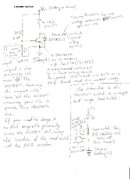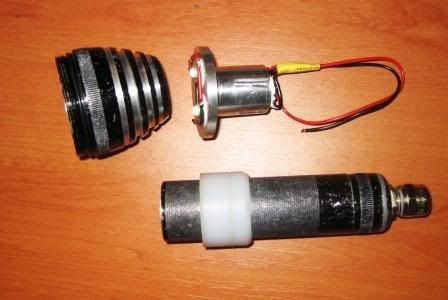martzak
Contributor
and for those who don't have the means to machine a piece of aluminum you'd offer what advice?
 .
.
Space is definitely not one of the constraints in my flashlight 'design', so I scavanged a piece of aluminum heatsink from a busted hair curling iron and attached it to my MOSFET with epoxy. Of course I used thermal compound between the aluminum piece and the MOSFET, then epoxy'ed around it to secure it. Something went wrong though. I was careful not to short any leads with the aluminum heatsink, I checked the conductivity of the epoxy and the thermal compound (lots of Ohm there). When the epoxy was partially set I connected the driver and everything worked fine.
Today, after the epoxy had a chance to set completely, the driver does not work. Input 8.33V, output 0V. I don't think anything got shorted. The only explanation I can come up with is that some epoxy might have gotten under one of the small surface mount resistors or caps around the mosfet and lifted them out of place as it set. I do believe epoxy expands slightly as it sets.
At any rate, I goofed up. Any other theories on what might have gone wrong in this experiment?? . Any similar experiences?
. Any similar experiences?
ps. It's not all lost though. I'm just back to driving my LED straight off the LI Ion battery pack (8 18650s in parallel, I know that's a lot). Funny thing is, the LED current straight off the battery pack never exceeds 3A, which is less than the driver I just busted .
.
Space is definitely not one of the constraints in my flashlight 'design', so I scavanged a piece of aluminum heatsink from a busted hair curling iron and attached it to my MOSFET with epoxy. Of course I used thermal compound between the aluminum piece and the MOSFET, then epoxy'ed around it to secure it. Something went wrong though. I was careful not to short any leads with the aluminum heatsink, I checked the conductivity of the epoxy and the thermal compound (lots of Ohm there). When the epoxy was partially set I connected the driver and everything worked fine.
Today, after the epoxy had a chance to set completely, the driver does not work. Input 8.33V, output 0V. I don't think anything got shorted. The only explanation I can come up with is that some epoxy might have gotten under one of the small surface mount resistors or caps around the mosfet and lifted them out of place as it set. I do believe epoxy expands slightly as it sets.
At any rate, I goofed up. Any other theories on what might have gone wrong in this experiment??
ps. It's not all lost though. I'm just back to driving my LED straight off the LI Ion battery pack (8 18650s in parallel, I know that's a lot). Funny thing is, the LED current straight off the battery pack never exceeds 3A, which is less than the driver I just busted





